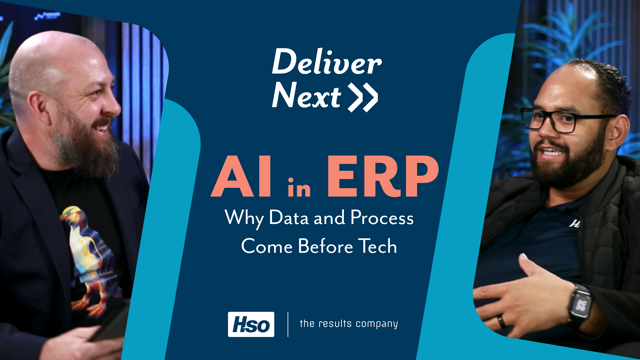Practical AI Use Cases

AI in ERP: Why Data and Process Come Before Tech

The following blog post is a summary of our discussion on the podcast created with the assistance of AI
Prefer to watch?
Wesley Nelson, ANZ Service Line Director at HSO, joins Nathan Bregmen to unpack what it really takes to make AI and ERP work together:
Why transformation starts with people and processes—not systems
How to clean your data before you automate
Quick wins like month-end close and supplier communications
Designing ERP for the next 5–10 years, not just today
Measuring ROI with the KPIs you already know
In a recent episode of Deliver Next, HSO Marketing Manager Nathan Bregmen interviewed Wesley Nelson, HSO’s ANZ Service‑Line Director, about the future of enterprise resource planning (ERP) and artificial intelligence (AI).
The conversation explored how AI can enhance ERP systems without losing sight of the people and processes that make businesses run. Wesley drew on more than two decades of experience, both as an ERP end‑user and as a consultant, to explain why getting the basics right—data, processes and culture—is the key to unlocking AI’s potential.
From End‑User to Expert
Wesley began his career on the front lines, using ERP systems to perform day‑to‑day tasks. As he grew into training and consulting roles, he gained a unique perspective on what it takes to make ERP projects succeed. His journey has taken him from customer roles to partner roles and now to his leadership position at HSO. This background allows him to speak credibly about both the pain points customers feel and the challenges implementation partners face.
People and Processes Come First
One of Wesley’s core messages is that digital transformation isn’t about the system—it’s about people and processes. Too often, organisations start by selecting tools and only then try to fit their processes around them. Wesley emphasised that success depends on understanding how work actually gets done. Before introducing AI, businesses should:
Map their current workflows to identify bottlenecks and inefficiencies.
Engage the people who perform those tasks to ensure the solution meets real needs.
Align technology decisions with the company’s culture and strategic goals.
By focusing on people and processes, technology becomes an enabler rather than a distraction.
Clean Data Is Non‑Negotiable
A second important theme was data quality. Wesley warned that AI doesn’t magically clean up bad data—if anything, it magnifies existing problems. Organisations that rush to deploy AI without standardising and cleansing their data often find that automation spreads errors faster.
To prepare for AI, Wesley suggests:
Consolidating data sources and eliminating redundant systems.
Establishing governance practices to maintain data integrity.
Ensuring that teams are trained on how to enter and manage data consistently.
Only when data is trustworthy can AI deliver meaningful insights and automation.
Future‑Proof Your ERP
Wesley cautioned against designing systems solely for today’s needs. He encouraged listeners to build for the future, so that ERP and AI investments can scale with the business. That means selecting platforms that can handle increased transaction volumes, new business models and additional geographies without forcing a costly re‑implementation. It also means thinking ahead to how AI agents and predictive capabilities will integrate with core processes down the road.
- 1
Month‑End Close:
Automating journal postings and reconciliations can dramatically reduce the time finance teams spend closing the books.
- 2
Supplier Communication:
AI agents can monitor purchase orders and automatically notify suppliers about delays or partial shipments, saving procurement teams hours of follow‑up.
- 3
Manufacturing Scheduling:
By analysing data from HR systems, production lines and order books, an AI‑driven scheduling agent can optimise shop‑floor sequencing—reducing downtime and increasing throughput.
- 4
Customer‑Facing Queries:
With clean data, AI chatbots can handle common invoice and order‑status questions, freeing staff for more complex work.
These use cases show that AI isn’t theoretical—it’s already delivering value when applied to well‑defined problems with reliable data.
Measure What Matters
Wesley advised organisations to measure success using the KPIs they already track, rather than inventing new metrics for AI. For example:
Financial performance: improvements in revenue, cost savings, or reduced inventory carrying costs.
Operational efficiency: shorter order‑to‑cash cycles, fewer errors and faster month‑end closes.
Adoption and productivity: higher user engagement, fewer manual tasks and less rework.
Process improvements: more automation and real‑time decision‑making.
By establishing a baseline and monitoring these indicators over time, businesses can demonstrate the return on their AI and ERP investments.
AI as an Enabler, Not a Replacement
Finally, Wesley stressed that AI is not here to replace people. Instead, its purpose is to automate repetitive tasks so that employees can focus on higher‑value activities like relationship building, creative problem solving and strategic planning. When organisations make this clear and involve teams early in the transformation process, they reduce fear and increase adoption.
Conclusion
The episode underscored a clear takeaway: the success of AI in ERP rests on data quality, process maturity and human engagement. Organisations that prioritise these foundations will be better positioned to harness AI for efficiency and innovation. Wesley Nelson’s practical advice—start with people and data, design for growth, and measure impact using real KPIs—provides a roadmap for leaders looking to deliver lasting value from AI in ERP.
Ready to Transform Your ERP with AI?
Turn your data, processes, and people into a foundation for intelligent growth.
Get in touch with our experts to explore how AI and Dynamics 365 can modernise your operations and unlock measurable ROI.

